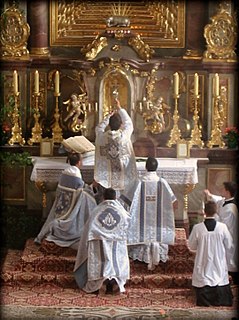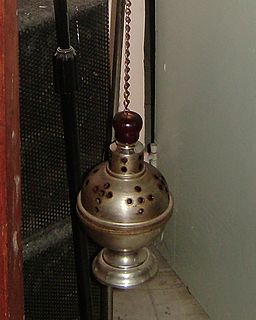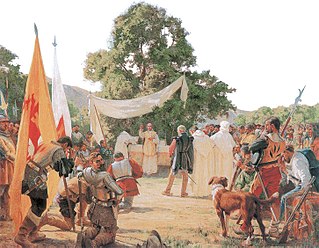
Mass is the main Eucharistic liturgical service in many forms of Western Christianity. The term Mass is commonly used in the Catholic Church, and in the Western Rite Orthodox, and Old Catholic churches. The term is used in some Lutheran churches, as well as in some Anglican churches. The term is also used, on rare occasion, by other Protestant churches.

The Tridentine Mass, also known as the Traditional Latin Mass or Traditional Rite, is the liturgy of Mass in the Roman Rite of the Catholic Church that appears in typical editions of the Roman Missal published from 1570 to 1962. Celebrated almost exclusively in Ecclesiastical Latin, it was the most widely used Eucharistic liturgy in the world from its issuance in 1570 until the introduction of the Mass of Paul VI.

A thurible is a metal censer suspended from chains, in which incense is burned during worship services. It is used in Christian churches including the Roman Catholic, Eastern Orthodox, Assyrian Church of the East and Oriental Orthodox, as well as in some Lutheran, Old Catholic, United Methodist, Reformed, Presbyterian Church USA, Anglican churches. In Roman Catholic, Lutheran, and Anglican churches, the altar server who carries the thurible is called the thurifer. The practice is rooted in the earlier traditions of Judaism in the time of the Second Jewish Temple.

In Christianity, a minister is a person authorised by a church or other religious organization to perform functions such as teaching of beliefs; leading services such as weddings, baptisms or funerals; or otherwise providing spiritual guidance to the community. The term is taken from Latin minister. In some church traditions the term is usually used for people who have ordained, but in other traditions it can also be used for non-ordained people who have a pastoral or liturgical ministry.

The kiss of peace is an ancient traditional Christian greeting, sometimes also called the "holy kiss", "brother kiss", or "sister kiss". Such greetings signify a wish and blessing that peace be with the recipient, and besides their spontaneous uses they have certain ritualized or formalized uses long established in liturgy. Many denominations use other forms of greeting to serve equivalent purposes; they include handshakes, gestures, and hugs, any of which may be called a sign of peace.
A stipend is a regular fixed sum of money paid for services or to defray expenses, such as for scholarship, internship, or apprenticeship. It is often distinct from an income or a salary because it does not necessarily represent payment for work performed; instead it represents a payment that enables somebody to be exempt partly or wholly from waged or salaried employment in order to undertake a role that is normally unpaid or voluntary, or which cannot be measured in terms of a task. A paid judge in an English magistrates' court was formerly termed a "stipendiary magistrate", as distinct from the unpaid "lay magistrates". In 2000, these were respectively renamed "district judge " and "magistrate".
Oblation, meaning an offering, is a term used, particularly in ecclesiastical use, for a solemn offering or presentation to God.

The Roman Rite is the primary liturgical rite of the Latin Church, the largest of the sui iuris particular churches that comprise the Catholic Church. It developed in the Latin language in the city of Rome and, while distinct Latin liturgical rites such as the Ambrosian Rite remain, the Roman Rite has gradually been adopted almost everywhere in the Latin Church. In medieval times there were numerous local variants, even if all of them did not amount to distinct rites, yet uniformity increased as a result of the invention of printing and in obedience to the decrees of the Council of Trent of 1545–63. Several Latin liturgical rites that survived into the 20th century were abandoned voluntarily after the Second Vatican Council. The Roman Rite is now the most widespread liturgical rite not only in the Roman Catholic Church but in Christianity as a whole.

A Christian burial is the burial of a deceased person with specifically Christian rites; typically, in consecrated ground. Until recent times Christians generally objected to cremation because it interfered with the concept of the resurrection of a corpse, and practiced inhumation almost exclusively. Today this opposition has all but vanished among Protestants and Catholics alike, and this is rapidly becoming more common, although Eastern Orthodox Churches still mostly forbid cremation.

The Mass is the central liturgical rite in the Catholic Church, encompassing the Liturgy of the Word and the Liturgy of the Eucharist, where the bread and wine are consecrated and become the Body and Blood of Christ. As defined by the Church at the Council of Trent, in the Mass, "the same Christ who offered himself once in a bloody manner on the altar of the cross, is present and offered in an unbloody manner". The Church describes the Mass as the "source and summit of the Christian life". Thus the Church teaches that the Mass is a sacrifice. It teaches that the sacramental bread and wine, through consecration by an ordained priest, become the sacrificial body, blood, soul, and divinity of Christ as the sacrifice on Calvary made truly present once again on the altar. The Catholic Church permits only baptised members in the state of grace to receive Christ in the Eucharist.

The sacrament of holy orders in the Catholic Church includes three orders: bishops, priests, and deacons, in decreasing order of rank, collectively comprising the clergy. In the phrase "holy orders", the word "holy" means "set apart for a sacred purpose". The word "order" designates an established civil body or corporation with a hierarchy, and ordination means legal incorporation into an order. In context, therefore, a group with a hierarchical structure that is set apart for ministry in the Church.
Cathedraticum is a specified sum of money to be paid annually toward a bishop. It is a mark of honour and a sign of subjection to the cathedral church, from which its name is derived.
An honorarium is an ex gratia payment, i.e., a payment made, without the giver recognizing themselves as having any liability or legal obligation, to a person for his or her services in a volunteer capacity or for services for which fees are not traditionally required. It is a common remuneration practice in schools or sports clubs, for teachers and coaches. Another example includes the payment to guest speakers at a conference meeting to cover their travel, accommodation, or preparation time. Services for Christian Church funerals and/or memorial services are often paid by honorarium, as the minister, musicians, organist, soloist and others, out of care, do not have a set fee for services to grieving families. Likewise, wedding officiants are sometimes paid through honorarium. When required, honorariums may be termed altarages, although an altarage may be paid to a church or parish rather than a person.
Summorum Pontificum is an apostolic letter of Pope Benedict XVI, issued in July 2007, which specified the circumstances in which priests of the Latin Church could celebrate Mass according to what he called the "Missal promulgated by Blessed John XXIII in 1962", and administer most of the sacraments in the form used before the liturgical reforms that followed the Second Vatican Council.

Daniel Edward Pilarczyk was an American prelate of the Roman Catholic Church. He served as Archbishop of Cincinnati from 1982 to 2009.
A Catholic funeral is carried out in accordance with the prescribed rites of the Catholic Church. Such funerals are referred to in Catholic canon law as "ecclesiastical funerals" and are dealt with in canons 1176–1185 of the 1983 Code of Canon Law, and in canons 874–879 of the Code of Canons of the Eastern Churches. In Catholic funerals, the Church "seeks spiritual support for the deceased, honors their bodies, and at the same time brings the solace of hope to the living." The Second Vatican Council in its Constitution on the Liturgy decreed: "The rite for the burial of the dead should express more clearly the paschal character of Christian death, and should correspond more closely to the circumstances and traditions found in various regions."
Altarage is a term once commonly used in an ecclesiastical context to signify the revenue reserved for the chaplain in contradistinction to the income of the parish priest — it came to indicate the funds received by a priest from the laity when discharging a particular function for them, e.g., marriages, baptisms, and funerals. The term is largely obsolete, having been replaced by the more specific honorarium, stipend, or stole-fee.
A Mass card is a card which indicates that a person, whether living or deceased, will be included in the intentions at a specific Catholic Mass or set of Masses. The donor makes a nominal donation to a parish or monastery at which the Mass will be said, and presents the card to the person or, if deceased, their family.
Funeral dues, under the 1917 Code of Canon Law, were the payments that are due to a priest under canon law for celebrating a Roman Catholic funeral. There also existed the right for a quarter of the funeral costs to accrue to the parish priest of the dead person if the person was buried away from the parish, which was known as the quarta funeralis.
A rector is, in an ecclesiastical sense, a cleric who functions as an administrative leader in some Christian denominations. In contrast, a vicar is also a cleric but functions as an assistant and representative of an administrative leader.










